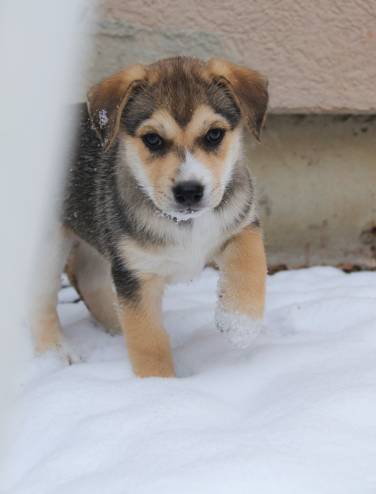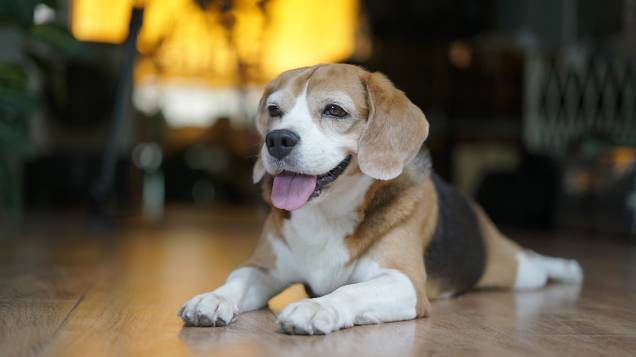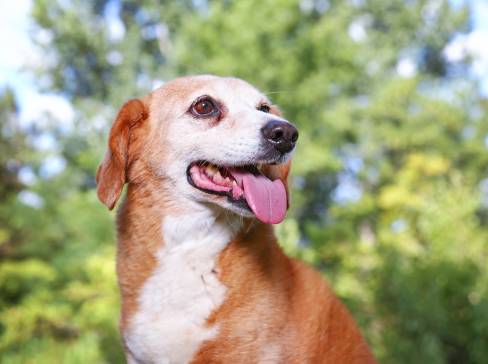Connect with a verified veterinarian in minutes. Licensed vets are available 24/7 to answer your questions. No need to worry about your furry family member.
Have you heard of the Beaski dog breed? If not, you’re in for a treat! If you’re looking to adopt a unique dog breed, this may be the right dog for you!
We’ve put together information about the Beaski to help you decide if this is the right dog for you and your family. Let’s get started!
What is a Beaski?
The Beaski is a hybrid dog breed that comes from crossing a purebred Siberian Husky and a purebred Beagle. This may seem like an unlikely pairing, but the Beaski is a unique designer dog.
Beaskis are sometimes referred to as designer dogs because breeders chose to mixed two dog breeds that are not related to one another. Designer dogs can also be called crossbreeds. Breeders sometimes choose to mix two different dog breeds to produce a designer dog that has the best attributes of both parents. What’s more, these dogs may also be healthier than their purebred parents.
Beaskis, like other designer dogs, can look different from other dogs of the same mix. That’s because each puppy, even in the same litter, randomly inherits genes from both parents. That means some dogs in the litter may look more like a Beagle, while others may strongly resemble their Husky parent. There may even be puppies that look more like a blend of both dog breeds. You just never know for sure how the puppies will turn out.
That means these dogs may have different coat textures and lengths, eye colors that vary, and different personalities and other traits.
We don’t know much about the history of the Beaski, but we can learn more about these dogs by looking at the dog’s parents.
Quick Overview of the Beagle
The Beagle was first developed in England to hunt fox and other animals. These dogs are classified as scent hounds, which means they primarily hunt by scent rather than sight. The dogs have excellent noses that can sniff out anything and everything. That’s why they’re often used at airports and other places to find contraband. They’re also used on search & rescue teams and more.
Beagles are small to medium dogs that are highly intelligent. However, they are also difficult to train as they can be a bit stubborn. They’re also kind and loving; Beagles can get along well with kids.

Review symptoms, medications & behavior to keep your pets healthy with a Vet Online in just minutes.
Ask a Vet Live NowThe Siberian Husky
The other purebred parent of the Beaski is the Siberian Husky. These dogs originally came from Siberia, where they were developed by the Chukchi people. The dogs were used as sled dogs to help the Chukchi in their nomadic life. The dogs are part of the Spitz family and are still used as sled dogs today.
And it’s no wonder the dogs are used for pulling sleds. The Siberian Husky has plenty of durability, speed, and energy to spare. These are large and athletic. They’re very playful and also get along with kids and other pets.
Huskies can sometimes be a bit challenging to train as they can be stubborn and have a tendency to “talk back.” However, they’re intelligent dogs and make loving family companions.
So, with parents like these, how could you go wrong with a Beaski?
Beaskis usually stand between 16 to 20 inches tall and weigh between 35-45 lbs. They have a life expectancy of 11 to 14 years.
Beaski Appearance
Each Beaski is a unique individual, and their appearance varies depending on which parent they take after. These dogs may have a double-layered coat that’s thick and comes in colors such as orange, white, brown, lemon, red, tan, copper, chocolate, silver, and combinations of these colors.
And the Beaski can have eyes that are amber, blue, brown, or eyes that are different colors!
Beaski Temperament
The Beaski is a highly intelligent and sweet-natured. They tend to be laid-back and protective dogs. This is a dog that loves to be affectionate and snuggle. Beaskis love their families and want to be with them most of the time. However, the dogs can also be somewhat independent and don’t mind being alone for a time. Even so, they can become bored, so it’s important to ensure the dog has plenty of dog toys and puzzles to keep him busy.
Beaskis can also be territorial and wary of strangers. For this reason, the dogs make great watchdogs. The dogs can also be stubborn, which can make them more challenging to train. However, they are also eager to please.
These dogs love being outside, but they should never be left alone in the yard for long periods. These are dogs that need to be with their families. In addition, the dogs are most comfortable in cooler climates.
Are Beaskis Good for Families?
Yes, the Beaski can be a great family companion. The dogs usually do well with kids; however, they are best with older kids that don’t play rough. These dogs are very protective of their entire family and their homes.
Do Beaskis Get Along with Other Dogs & Pets?
Beaskis that have been trained and socialized from a young age do well with other dogs. They can also get along well with other pets, including cats and small animals.
However, some of these dogs may have inherited a strong prey drive from their Beagle parent. In that case, they may chase after cats, squirrels, and other small animals.
The dogs can also be somewhat territorial. They are not friendly to any animals or humans who don’t belong in their yards. They aren’t likely to bite; however, the dogs may bark quite loudly if a stranger is near or in their yard.
Food & Diet Requirements
Beaskis are medium-sized dogs that have a lot of energy. For this reason, they require dog food that contains high amounts of proteins and healthy fats.
Exercise Requirements
Beaskis require a moderate amount of exercise every day. They will love having a couple of 30-minute walks each day, along with playtime in the backyard. The dogs can also be taught to help around the house with small jobs and tasks to provide additional mental stimulation.
Training
These dogs are not easy to train; however, they’re also not that challenging. The dogs are smart and easy to please; however, they can be somewhat stubborn and independent. They work best with a pet parent who understands how to manage and train these dogs. Beaskis benefit from consistent training that’s based on positive reinforcement training methods.
Summing It Up
So, there you have it! The Beaski is a wonderful hybrid dog that’s a combination of the Siberian Husky and the Beagle. The dogs are highly intelligent, easy-going, loving and they make great family companions. They have a lot of energy, so they need plenty of daily exercise.
We’re pretty sure if you choose to adopt a Beaski, you’ll have a loving, protective, fun companion for years to come!
Connect with a verified veterinarian in minutes. Licensed vets are available 24/7 to answer your questions. No need to worry about your furry family member.

Kim
Kim is a talented author, who loves animals especially dogs. She engaged in writing books and articles relating to animals a decade ago. Kim resides in Chicago with her husband and son. The family is the proud owner of a dog and a parrot (Jack and Lily). Kim wanted more than these two pets, but her husband put his foot down... She often visits elementary schools to talk to the kids about what she learned about pets and how they could learn from them.
Review symptoms, medications & behavior to keep your pets healthy with a Vet Online in just minutes.
Ask a Vet Live Now




